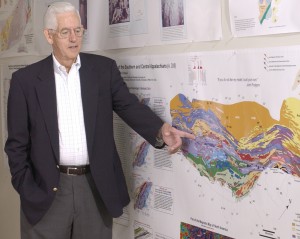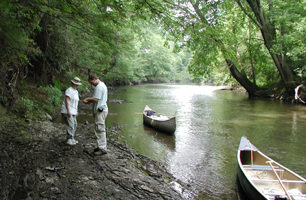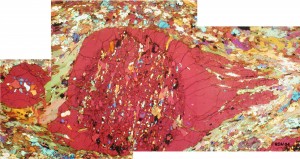
Pointing out features on the tectonic map of the southern and central Appalachians (published by GSA in 2007).
These are my primary research interests. While we employ stratigraphic, petrologic, geophysical, geochemical, and geochronologic data to address the origin and evolution of these features, we view the world through “structural geology–colored glasses.” A multidisciplinary approach is employed, however, to address the complex processes related to the construction of mountain chains and continental crust. We work with structures on all scales, from microscopic to map–scale to 3–D visualization and modeling; incorporate available geophysical data; obtain geochemical data to determine the sedimentary and igneous origins of metamorphic rocks; determine P–T conditions of deformation and metamorphism; obtain geochronologic data on ages of rock units and magmatic or detrital components to bracket times of deposition, intrusion, and metamorphism; and conduct basin analysis to understand sedimentation processes and basin evolution. While we employ many laboratory techniques to solve problems, we are primarily field geologists—detailed geologic maps that we make form our primary, quantitative data sets. We have always tried to consistently draw conclusions and formulate models that are strongly bonded to the data we collect, plus the high quality data produced by others, that can be incorporated into our analyses. New research avenues are identified by surprises that are the rewards of carefully formulated and executed research projects that lead to formulation of new ideas, along with the surprises that make field-based scientific research worthwhile.

Graduate students collecting data during a canoe traverse along a river in the Valley and Ridge.
Although most of my research has been in the Appalachians, and I am frequently categorized as an Appalachian geologist, the Appalachians serve as a classic “back–yard” orogen through which other orogenic belts can be understood. I have visited the Canadian and U.S. Cordillera, British and Scandinavian Caledonides, Alps, Moroccan High Atlas and Meseta, Carpathians (Tatras), and Argentine Andes, several times, and have spent smaller amounts of time in the Xinling Mountains in China, the Ol’khon region in Siberia (early Paleozoic orogeny overprinted by the near modern extensional tectonics that formed Lake Baikal), and the Mexican Cordillera, as well as in parts of the Canadian Shield and Argentine Sierras Pampeanas. M.S. and Ph.D. theses have been completed in the Appalachians, Alaska, Norway, and the Colombian Andes.

Garnet (~3mm wide) in a sillimanite gneiss from the central Blue Ridge in southwestern North Carolina (crossed polars with a gypsum plate). This garnet envelopes an earlier garnet that contains a relict foliation that was rotated before growth of the new garnet without inclusions. The younger garnet formed as the rock mass was being deformed by simple shear producing a σ shape of the garnet indicating top-to-the right shear sense.
Most of what we do is basic research, but with ready spinoff into engineering, hydrocarbon (and mineral) exploration, earthquake and landslide hazards, and radioactive waste disposal problems. Some of our recently completed research involved attempts to understand the geologic controls of hydrocarbon distribution in Tennessee and nearby Kentucky. A current research project is related to seismic hazard in the East Tennessee seismic zone, one of the enigmatic intraplate seismic zones in eastern North America. Here, we have discovered several faults that deformed Paleozoic bedrock against Quaternary river sediments; dating of one of the faults revealed that movement on this fault (a thrust) occurred more recently than 15,000 years ago.
As a result of the interdisciplinary nature of our research, students find employment in a variety of places ranging from universities, federal agencies and laboratories, state geological surveys and other state agencies, to petroleum companies, engineering and environmental firms.